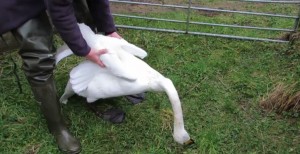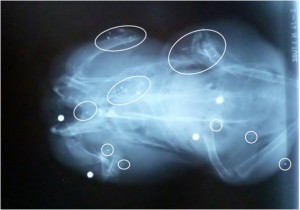Lead ammunition poisoning - new figures

Up to 100,000 wildfowl (swans, ducks and geese) are estimated to die each winter in the UK countryside due to lead poisoning from spent gunshot, according to research published today. It’s estimated that large numbers of terrestrial birds also die.
At least 2,000 tonnes of toxic lead shot pellets – the equivalent weight of 2 million bags of sugar - is used to shoot live quarry in the UK each year1. Most of it is irretrievably deposited on the ground where it can be ingested by birds who mistake it for grit or seeds. A further 3,000 tonnes of lead shot is deposited on clay shooting grounds.

Lead from ammunition can also enter the human food chain when people eat wild-shot game. When lead ammunition passes through an animal it can fragment into tiny pieces that are often too small to be seen or cut out (especially in game birds) and these fragments can be solubilised and absorbed.
WWT, RSPB and the Sustainable Food Trust would like to see lead ammunition phased out by the end of 2017 and replaced with non-toxic alternatives which are effective, affordable and readily available.
Today’s figures, which are part of the proceedings of a symposium on the risks from lead ammunition held at Oxford University, draw on hundreds of scientific sources, including research by WWT and RSPB. There is widespread scientific consensus on the evidence of toxic risks from lead ammunition, and the need for it to be phased out. The new figures include:
- Up to 100,000 wildfowl (mainly wild swans, ducks and geese) are estimated to die every winter as a direct result of ingesting poisonous lead shot. For migratory swans, lead poisoning accounts for a quarter of all recorded deaths. Many terrestrial game birds die in a similar way.
- In a recent study 77% of ducks purchased as locally shot from suppliers in England were illegally killed using lead rather than non-toxic alternatives. This suggests a shooting industry campaign to “use lead legally” was not successful, despite being signed by thousands of law-abiding shooters.
- Thousands of children in the UK per year (in the range 4,000 - 48,000) could be at potential risk of a one point reduction in IQ or more as a result of current levels of exposure to ammunition-derived dietary lead. Children and pregnant women are the most vulnerable to the effects of lead.
WWT Chief Executive Martin Spray CBE said:
“You can’t deny the clear and powerful narrative of hundreds of research papers and the consensus of scientists from around the world who agree lead is a poison, its use in ammunition presents significant risks, and that exposure to it should be minimised.
“Voluntary and partial restrictions on the use of lead shot have not worked. We believe there is now no practical option left short of phasing out lead ammunition. We’ll continue to work with the Government and stakeholders to facilitate a smooth transition to the use of non-toxic alternatives.
“This issue is about reducing an unnecessary pollutant in our countryside, not about the wider ethics of shooting.
“A phase-out would mean far fewer wildfowl and game birds being poisoned; low-lead meat could be a great selling point for the UK game industry; and Danish hunters tell us that using non-toxic shot for all shooting, which they have done for nearly 20 years, is important for the reputation of the sport.”
RSPB Head of Nature Policy, Jeff Knott said:
“Lead poisoning from ammunition is an issue wherever it is deposited. We now know the impacts extend beyond wetlands to terrestrial habitats and could impact a range of species.
“We welcome the adoption of the Convention on Migratory Species resolution on poisoning last year, which clearly set the direction of travel towards a lead free future. These proceedings are a helpful further contribution to the evidence base pointing the way. We must all now focus on how we can help achieve that objective.”
Sustainable Food Trust Policy Director, Richard Young said:
“The Sustainable Food Trust strongly supports calls for an end to the use of ammunition containing lead.
“There are many difficult challenges to make food systems safe and sustainable, but this one could be solved very simply by regulating to stop the sale of ammunition containing lead and promoting its replacement with non-toxic alternatives instead."
The Government were recently advised by a stakeholder group of the risks from lead ammunition and that its replacement with non-toxic alternatives is the only option likely to address these risks. An international agreement, the Convention for Migratory Species, has also passed a resolution for member countries – including the UK – to phase out lead ammunition by the end of 2017. In 2014, 30 human and wildlife health experts from 10 European countries signed a consensus statement on the evidence of the toxic risks from lead ammunition, and recommended it be phased out.
The Government is yet to act, even though the Food Standards Agency has advised frequent eaters of lead-shot game to reduce their intake.
Alongside these figures, WWT has released new video footage to illustrate how lead poisoning affects birds that ingest lead shot – something which few people in the countryside ever get to see.
Lead poisoning is an ‘invisible killer’ because in the wild lead poisoned birds are usually scattered and hard to find, and readily eaten by predators and scavengers. However, occasionally large numbers of birds will die from feeding in one area. In the video, hundreds of ducks on this farm died after feeding on land contaminated with lead shot, next to a clay pigeon shoot. While this type of die-off in farmed birds is quite rare, large numbers of wild birds suffer the same effects as these ducks from lead poisoning every year.
- The Oxford Lead Symposium was convened at The Edward Grey Institute, University of Oxford in December 2014 to examine research on the risks to human and environmental health from lead ammunition, and means of minimising these risks. Papers from the symposium were peer reviewed.
1Shooting industry figure quoted here: http://www.leadammunitiongroup.org.uk/wp-content/uploads/2015/09/LAG-Letter-to-SoS-Environment-030615_Redacted.pdf
